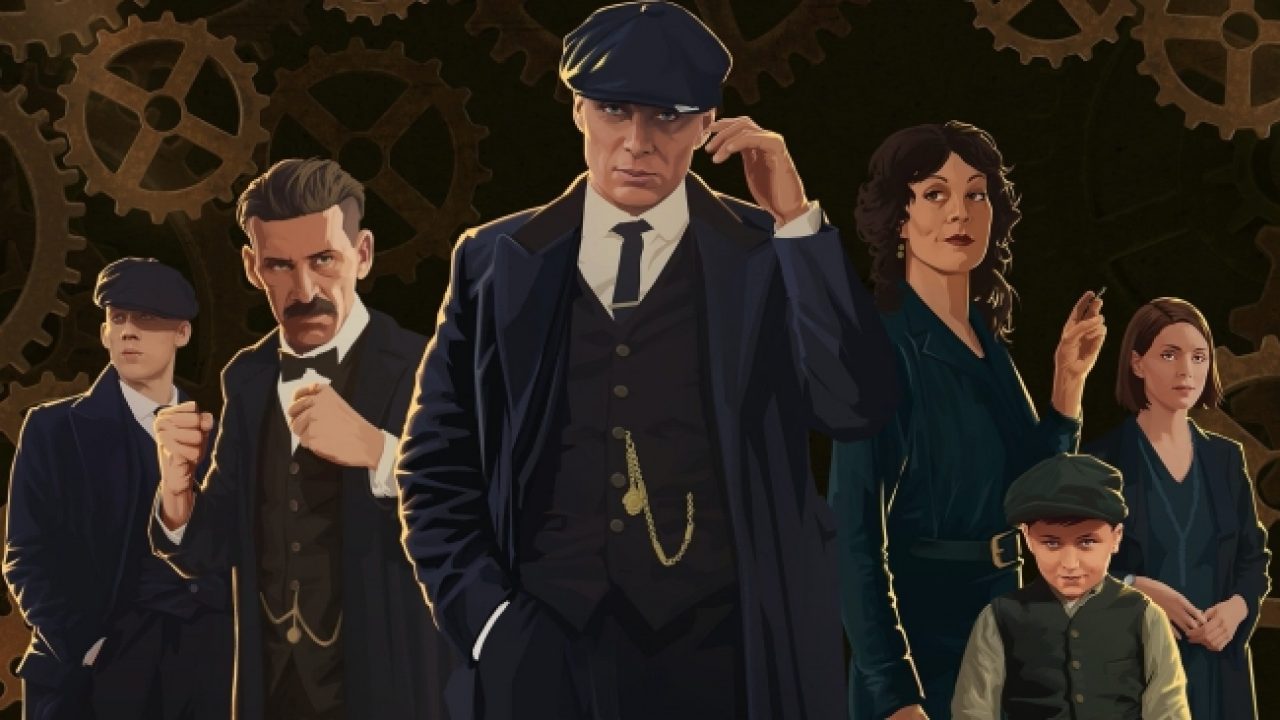Peaky Blinders: Mastermind (PS4) Review – The Soldier’s Minute
Fun Fact: The only reason I began watching the Peaky Blinders TV show was because I’d seen the news that Futurlab were developing a game for the IP. It’s no secret that the Brighton based indie outfit are one of my favourite developers. They’ve created some of this generation’s most creative titles like Velocity 2X and Mini-Mech Mayhem. They have a knack for “finding the fun” in their titles and they’ve been doing so for a decade. So I decided that if I was going to get the most out of Peaky Blinders: Mastermind, I was going to need to watch the TV show for context. I’m glad I did.
I immediately fell for the characters and their dynamics, the antics, the world and the tension each episode delivered. I binged three seasons in the space of a week and it became obvious why it had become such a cultural phenomenon in the UK. It’s clear while playing Peaky Blinders: Mastermind that Futurlab love the franchise and the Shelby’s too.
I couldn’t help but be reminded of John Wick Hex while playing Peaky Blinders: Mastermind. Not because the games share much in terms of content but because both of these games display a deep understanding of why people enjoy the source material they’re based on. When you think about the aspects of Peaky Blinders that stick in people’s minds it’s likely to be the banter and dynamic between the Shelby’s, the way they brand themselves via fear or respect, the haircuts, the suits, the coats, flashbacks to the war, the period inappropriate yet slick soundtrack, the style of the world but most importantly, the calculated nature of Thomas Shelby and the way he plays Small Heath like a game of Chess he’s always going to win. It would probably have been easy to put together a first person shooter and slap the Peaky Blinders name on it but that wouldn’t have done the source material any justice. Instead, Futurlab have created a top down, time based real time puzzle strategy game that has you controlling the whole Shelby clan simultaneously. It’s an inspired way to incorporate much of what’s great about the TV show and seems to revolve around one of the most poignant moments from the first season; the soldier’s minute.
“The soldier’s minute: in a battle, that’s all you get. One minute of everything at once. And anything before is nothing. Everything after: nothing. Nothing in comparison to that one minute.”
Peaky Blinders: Mastermind is a prequel of sorts to the first season of the TV show. Thomas, Arthur and John Shelby have returned from the war to once again rule over the streets of Small Heath. Polly and Ada have kept the family book making business running while they’ve been away. Now the trio are back, they want to celebrate and they want to do so in style – with a big champagne blow out at the The Garrison. The issue is that the bubbly is in short supply and the biggest stock is in the hands of a rival family, The Gilroy’s. The Peaky Blinders do what they do best and “acquire” said champagne but in doing so, they ruffle some feathers and draw the ire of others that are determined to bring trouble to the Shelby door.

The narrative in Peaky Blinders: Mastermind is in keeping with what you’ll have seen in the TV show. There’s a conspiracy afoot and it’s causing grief for the Shelby’s who’re as hell bent on causing as much mischief as they can on the road to getting to the bottom of who’s causing them trouble. The story is delivered in painterly stills, complete with the likeness of each of the actors, that bookend each of the game’s 10 chapters. While there’s no voice acting here, the text dialogue is in perfect step with how the characters interact in the show. Pol is always there for the sly one liner, Arthur acting as the head of the family is quick to anger and Tom, well, he’s Tom. Divulging just enough to keep his family and the player invested while playing the long game. Outside of the immediate Shelby family, a few regulars from the TV show make an appearance, some as simply cameo’s and others as large plot devices.
If there was one criticism I’d make of the plot it’s that because it’s a prequel, it’s a little too easy to guess what happens to those named characters who don’t appear in the TV show. We also know that every playable character in the game survives, which removes some of the threat to those characters. But that’s kind of the point to Peaky Blinders: Mastermind. It’s not about surviving a Small Heath gang war. It’s about doing it in the style and synchronicity that’s so prevalent in the TV series.

Presented in an almost top-down view, the aim of each level is to complete objectives with each of the available Peaky Blinders. For the most part that involves following breadcrumb like markers and way points that are colour coded for each Shelby/Grey. The kicker is that all of these objectives have to be completed simultaneously. In order to do that, the player is able to rewind and fast forward time with a press of a button and change which character you’re controlling on the fly.
The whole of Peaky Blinders: Mastermind is designed around the abilities of each member of the gang. In the mean streets of Birmingham there are guards who’ll bring the hurt and reinforcements to the Shelby’s should Tommy, Arthur, John of Finn cross their paths (or vision cone, as it’s presented in-game). Ada and Polly though? Well, they can move through the city without being stopped. Both of the women can also assist the men to get past patrols – Ada can distract guards to vastly reduce their vision cones while Pol can bribe them so they look the other way entirely. Polly’s also able to pick locks, handy in a pinch. Both Arthur and John are adept fighters and as such can engage in 1-on-1 scraps with some (non-guard) foes. If they’re out number though, they’ll need to team up together. These brawls always end in a very satisfying slice to the face with the peak of a flat cap. Arthur, being the volcano of aggression that he is, can kick in some locked doors while John can set ablaze some flammable obstacles to open up new routes. Tommy is a little different. He doesn’t engage in fisticuffs but can talk some NPC’s into becoming an ally’s and controllable characters for a short time. Need a locked door opening? Have Tommy give the guy inside a word through the window. Lastly, there’s Finn. Able to squeeze through small spaces like holes in walls or through windows, Finn is the sneaky Peaky who can pick a pocket or two, should the need arise. All of the Blinders are capable of doing universal things like opening doors (some of which are one way or auto-close when not being interacted with) or pushing around some objects.

The structure of all but one of the levels is designed around moment to moment problem solving through team work. Tommy needs to get to the other end of the docks but there’s guards everywhere? You’ll need to overcome the issue step by step, rewinding as you go to bring another Peaky Blinder in to help out. By using Ada to distract a guard, rewinding, using Polly to bribe another, rewinding, then using Finn to slip through a crack in a wall, grab a key and unlock a gate, rewind, all character will act simultaneously when you press play. This’ll make a hole in the patrol big enough for Tommy to slip through. The actions and movements you perform as each character are committed to a time line and will be repeated if you rewind time and let it play out. If you’re unhappy with you’re previous actions you can simply rewind them and alter them. There’s no “game over” screen in Peaky Blinders: Mastermind. It’s more like “do better” where it’s simply a case of having to rewind to fix your mistakes.
Your performance on each of Peaky Blinders: Mastermind’s levels is gauged by how long it takes to complete the level in spent time. While a level might take 20 minutes to complete a level, rewinding a refining your path and puzzle solving, the spent time might be only 3 minutes long. Judged at Gold, Silver or Bronze, you’ll need everything to be flawless for the highest rewards.

The first few levels of Peaky Blinders: Mastermind ease you in gently to this system because it can take a little getting used too. Especially the busy UI and on-screen prompts which can be overwhelming at times. By the time you reach level 5, the time lines to achieve things are tightened while the dependency of each Shelby increases. John and Arthur will take 2 very seperate routes through the streets of Birmingham, completing different objectives before needing one another to solve a problem later. This is where this game shines brightest – if you’ve done everything right and got the timing spot on, you’ll have John and Arthur rounding seperate corners at the same time to take on a pair of guards, Finn slipping through a gap between them to grab a lantern to hand off to John who’s now done with his fight. As Arthur kicks in a door and makes a beeline for another fight, John sets a pile of wood ablaze which allows Finn to move on past a guard. It’s magical when it all comes together.
By the time you get to the last 3 levels, there’s no room for error. Success and failure, forcing a rewind, are measured in tenths of a second rather than the minutes you get at the start of the game. The lattice of interwoven dependencies – Ada enabling Polly enabling Arthur enabling John enabling Tommy to do their job – become quite tense to manage, despite the fact you know there’s no real threat to the Peaky Blinders. I know Finn survives this prequel but my feet are still twitching as I attempt to reach Jeremiah the preacher in order to block the road before the pocket watch hits zero. It’s a masterful series of mechanics which really come into there own before the end of the game. I only wish Peaky Blinders: Mastermind had shown the sleekness of design it demonstrates in the late game much earlier and for longer.

There’s obviously been time and effort spent by Futurlab to create a faithful visual representation of Small Heath in this game and it certainly shows. The rough alleys, dockside works, warehouses and pubs bring that Peaky Blinders style from the TV to the video game in believable fashion. There’s life in these area’s too. NPC’s will wander around going about their day as you strut on through. The game also goes beyond Birmingham during a level in a graveyard which splices the real with the remembered from the war, again tying the game to those aspects of the TV show that fans have loved. While this gams isn’t going to be winning any medals for “Best looking game of 2020”, the art style carries the feel of the game a long way.
Matching the Peaky Blinders brand goes beyond just the look for Mastermind. It permeates the sound effects and music too. When you’re controlling each character, you’ll be treated to their own individual instrumental sounds when completing objectives. These sounds often combine, coming close to what you’ve heard the TV show. The sound track to Peaky Blinders: Mastermind is brilliant, it has to be said. A collaboration with Feverist, the band who were involved in scoring season 1 of the TV show, it’s an original group of songs that carry that “out of era yet still strangely suitable for this scene” indie music vibe that the TV show does so well.

There is one persistent technical issue with Peaky Blinder: Mastermind that I must mention. On occasion, after transitioning between areas of a level, the textures for the area fail to load. The floors and ceilings all appear totally black with furniture seemingly floating in the air. Walk back through a door and return to the glitches area and this issue usually goes away meaning it isn’t game breaking but it does cause a little confusion each and every time it happens.
If I was to nitpick, I felt there was a small disconnect between Arthur’s character and his abilities too. It felt a little strange to be sneaking around avoiding the gaze of a lonely guard one moment and then kicking the ever loving snot out of a group of rival gang members the next. For a character that’s so fast to violence, the Stealth aspect of his game play didn’t really work for me.

It also needs to be said that if you’ve not watched the Peaky Blinders TV show, much of the fan service that’s paid during Mastermind will just pass you by. This feels like a game made for fans, by fans and while a newcomer to the life of the Shelby’s could certainly enjoy the game play, the context around why it’s inspired would be totally lost on you. At least watch the first season of the show before playing this game. You’ll thank me for it.
A few issues aside, Peaky Blinders: Mastermind is a celebration of the TV sensation that translates much of what is loved about the show into tangible game play systems. The last third of this game is a brilliant showcase of the time manipulation mechanics and puzzle depth that can really push the player and offers oodles of tension. It’s simply a shame that it takes two thirds the game for that to be realised and for it to end so soon after it begins.
7/10
Peaky Blinders: Mastermind is launching on PS4 (reviewed on a standard PS4), Xbox One, Nintendo Switch and PC on August 20th, 2020.
Developer: Futurlab
Publisher: Curve Digital
Disclaimer: In order to complete this review we were provided with a promotional copy of the game. For our full review policy, please go here.
If you enjoyed this article or any more of our content, please consider our Patreon.
Make sure to follow Finger Guns on our social channels –Twitter, Facebook, Twitch, Spotify or Apple Podcasts – to keep up to date on our news, reviews and features.



